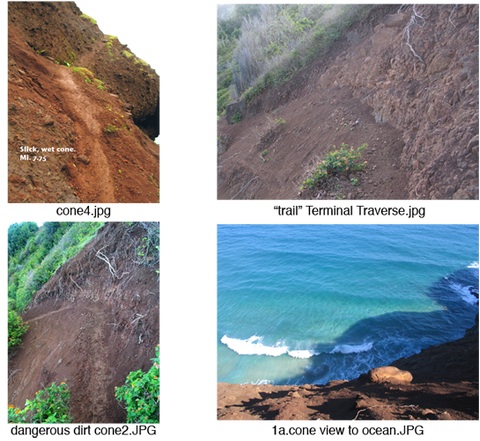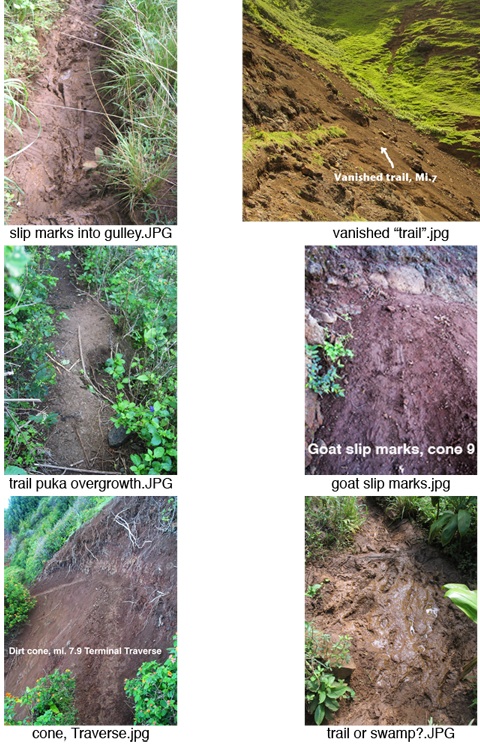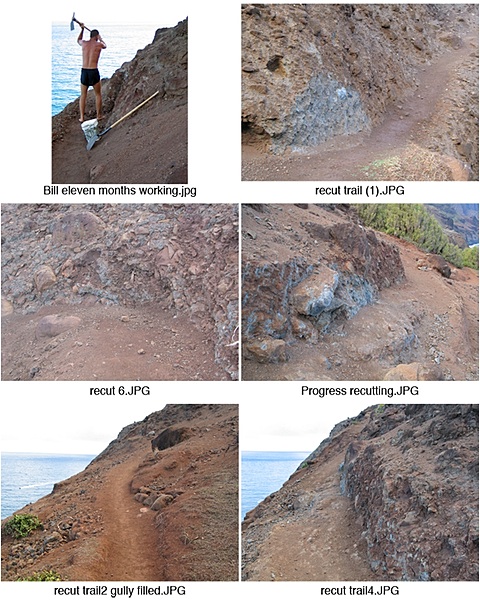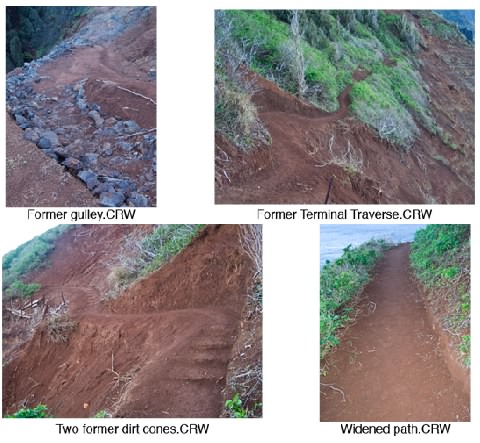www.islandbreath.org ID#0809-26
SUBJECT: KALALAU TRAIL
SOURCE: ARIUS HOPMAN ahopman@earthlink.net
POSTED: 5 JUNE 2008 - 2:45pm HST
The Na Pali Coast Trail needs more work
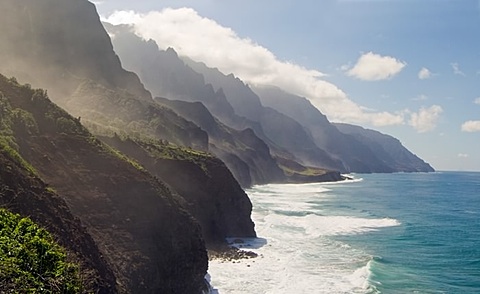
image above:Trail and cliffs below Terminal Traverse. Photo by Arius Hopman www.hopmanart.com
Several events recently have made the restoration of the Kalalau Trail not only urgent, but now achievable with fewer resources than considered formerly possible. In recent years the trail has deteriorated to dangerous proportions. There has been one death and major injuries on the trail that have required expensive evacuations. (see photos below taken before trail work began)
For a detailed report on Na Pali Trail conditions click here for Trail PDF (1mg). A State grant has been approved (but not yet released) to the Kauai Planning and Action Alliance (KPAA) for fixing the first two miles of the trail. New events show that the equivalent of the proposed funds could fix the entire Kalalau Trail, not just the first two miles. A former Marine and professional stone mason, Bill Summers, has volunteered ten months of his time (and $11,000 of his own savings) to restore the most dangerous two miles of the trail. His work has given us realistic guidelines for what is possible. His restoration is well planned, masterful and he is willing to train others and continue this important work, if he is given a chance. If the State works fast it can hold on to the rare opportunity he represents: He is running out of his own savings. The Trail and Valley • Kalalau and the Na Pali are remote and can therefore be easily overlooked when other departments clamor for limited State funds. Campers and kayakers pay a nightly fee while the many helicopter over-flights, which bring in constant noise pollution that reverberates off the amphitheatre-like cliffs, don’t pay a dime. The profile of the average hiker/eco-tourist is well educated and well off. They inevitably also spend their resources on expensive hotels, restaurants and shops. • A seasoned camper faced with an 11 mile hike on which he or she will have to ascend and descend 5000 cumulative feet, will consider every ounce they carry with them. When the Trail is neglected and becomes too dangerous to hike, campers are more likely to get dropped off illegally by motor boats. They are tempted to carry far more belongings than they could possibly carry on the trail. The surplus is likely to become garbage when they leave. • The initiation of walking the trail gives hikers a much greater perspective, respect and appreciation for the Valley than those who take a boat in. Na Pali attracts eco-tourists from all over the world, many of whom have had to turn back when they are confronted with the appallingly dangerous trail conditions. • The Trail and Valley deserve Heritage Trail status or Legacy Trail status. They have great Hawaiian and post-contact significance. They are cultural artifacts that still have significance to modern Hawaiians. The scenery and rare endemic and endangered ecology add further importance to both. • A neglected trail is dangerous and results in disrespect of the State Park. • The Dept. of Land and Natural Resources (DLNR), whose responsibility it is to manage the Na Pali State Park cites a $150,000,000 deficit of funds over the last few years as the reason for low management and low maintenance. The Opportunity The State grant was written to restore the most used (and equally neglected) portion of the trail between the trail head and mile two. The sums requested did not reflect the new, more cost-effective, low tech state of the art stone mason approach to the trail that Summers represents. Please see the accompanying papers and photographs that show the trail status before and after Bill’s work. There are two “before” photo contact sheets and three “after”, and three documents. Summary, Before and After Summer’s Restoration: • Cones of dirt that funnel onto the trail from above that approximate the incline of the cliffs. Even goats slip off these cones. • Sheets of dirt that slide onto the trail from above, inclining the trail bed. • Erosion holes in the trail from goats, runoff and hikers who get pushed off the trail by encroaching brush. • Unsecured stream crossings. • Woody brush encroaching on the trail (diminishes visibility, narrows trail, pushes hikers off). • Gullying of the trail, especially in slick volcanic mud. • Severe erosion caused by goats and low goat control. Summers has addressed all these problems in the two mile stretch he adopted. He has leveled many dirt cones, stepped steep sections, cut down shoulders that lead to cupping and eventual gullying, filled gullies with rock, thereby preventing further erosion, filled trail holes with strategically placed rocks, closed goat accesses to the trail with brush that was cut where it was encroaching onto the trail and placed stable stepping stones across the main stream in his adopted area. He has also broken down rock outcroppings and boulders weighing many tons and cut sections of trail into the rock where needed (see photos below taken after trail work).
Summers has certainly saved injuries and may have saved lives as well. He does the work because he knows that it is necessary, and nobody else is doing it. He understands better than anybody the Herculean task ahead to restore the entire trail to its’ former status under private ownership: a trail two-to-three foot wide and graded to shed water with minimal erosion. The Proposal: Summers is running out of his own savings, but wants to continue the work. Ideally he would like to be reimbursed for what he has spent on the trail so far and get enough of an income to buy food while he continues working. He has been using $1,200/month, which sum would keep him on the job. His status would continue to be that of an independent volunteer/contractor/instructor. It is clear, however, that to restore the entire trail to safe standards, from mile two to Kalalau Beach, will require a crew of four to six people who systematically address each section of the trail and bring it up to standard. Summers is willing to train them in the basics of stone masonry, drainage control, erosion control, trail restoration and maintenance. The training phase would of course also involve actual restoration. A stone mason with Summers’ extensive experience and understanding of the specific problems of the Kalalau Trail, is a big opportunity that is not likely to come around again. There is some urgency in finding Summers at least some temporary financing so he does not leave to earn a living elsewhere. The Budget Draft:
Traits of a Perfect Trail Worker • Is resourceful and hardy; an experienced camper. • Is in top physical condition. • Is willing to learn by observation and training. • Can sustain trail work for weeks or months. • Is energy-efficient and environmentally conscious. • Understands the need to protect endangered species. • Is self-reliant and self-responsible. |
see also:
Island Breath: Na Pali - Fortess Coast 3/31/08
